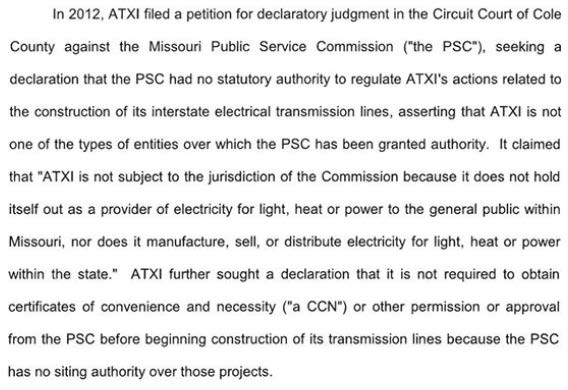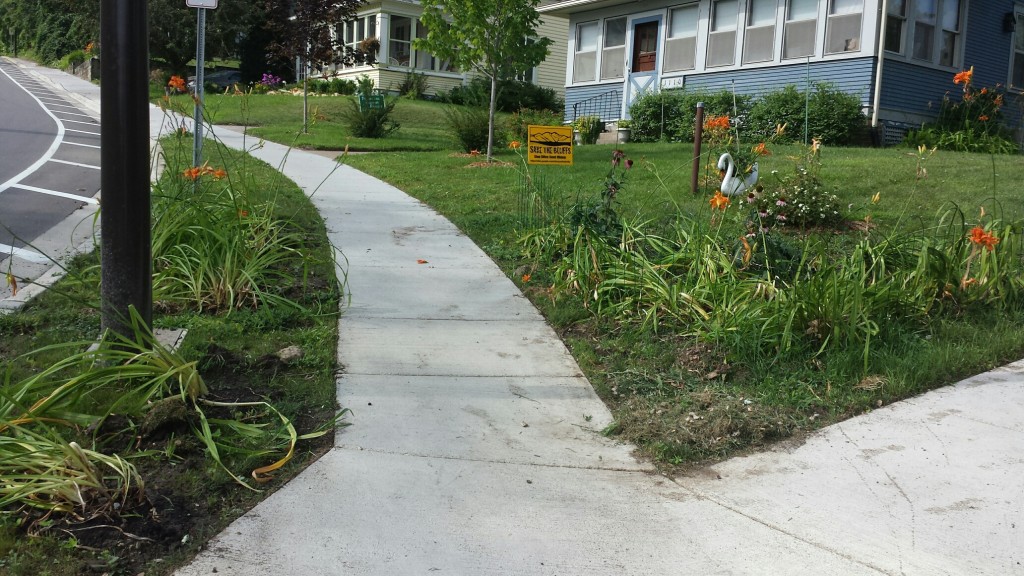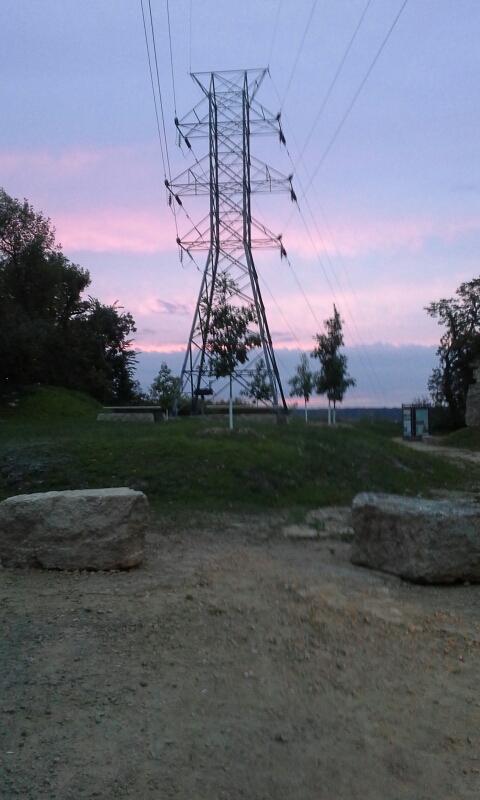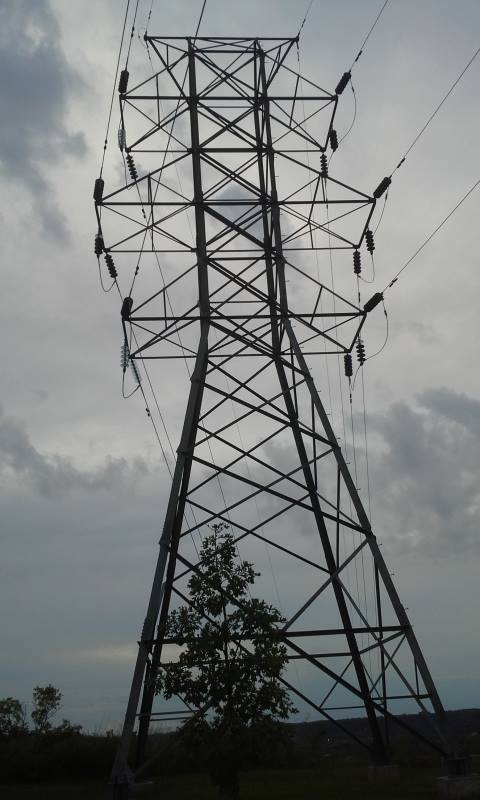ATXI shot down by Missouri Appellate Court
August 11th, 2015
Check out this great slap down of Ameren Transmission Company of Illinois by the Missouri Court of Appeals when Ameren challenged the lower court’s dismissal of their attempt to circumvent state regulation (thanks to Paul Henry for passing this on):
As you know, Missouri is the state that had the wherewithall to declare that Grain Belt Express and its Clean Line was not a utility. In this case, Ameren went in and said, with it seems quite a bit of arrogance, Missouri, don’t touch me, we don’t have to play with you, you don’t regulate me:
 WOW, whew, that sure didn’t work for Ameren. Love it when that happens.
WOW, whew, that sure didn’t work for Ameren. Love it when that happens.
Plantings in Red Wing
August 9th, 2015
 Thanks to Sheila in Frontenac who gave us TWO van loads of day lilies. They’re in, looking kinda bent up and tired, they’ve had quite a journey, but they’re perking up and next year they’ll look like something, and the year after, even better. The grass wasn’t coming in on the boulevard after the West Avenue redo, it looks like crap, so let’s see how the day lilies do. To be covered with chips soon, we have lots of the left over from the West Avenue construction. And on the other side, in the yard, in addition to the day lilies, I’ve added a bee balm and a few cone flowers. Soon, the Little Free Library on the metal post, and I found the perfect browsing chair to chain to the post. Before winter?
Thanks to Sheila in Frontenac who gave us TWO van loads of day lilies. They’re in, looking kinda bent up and tired, they’ve had quite a journey, but they’re perking up and next year they’ll look like something, and the year after, even better. The grass wasn’t coming in on the boulevard after the West Avenue redo, it looks like crap, so let’s see how the day lilies do. To be covered with chips soon, we have lots of the left over from the West Avenue construction. And on the other side, in the yard, in addition to the day lilies, I’ve added a bee balm and a few cone flowers. Soon, the Little Free Library on the metal post, and I found the perfect browsing chair to chain to the post. Before winter?
And speaking of plantings, we often have a picnic up on Memorial Bluff at the lower quarry, the beautiful newly refurbished area with huge stone benches overlooking the garbage burner. They’d reopened it last year, but this year, it was clear most of the newly planted trees had died. Tonight I saw there were new ones… GREAT! But look, really, 6 of them are planted under the transmission line. It’s bad enough that they put two big stone picnic benches under the transmission line, but TREES? How long will it be before our friends at Xcel Energy mow them down?
Biden? A distraction, not a contender.
August 7th, 2015
Joe Biden and Champ
I wish Joe Biden would get over himself and stop musing about a Presidential run. He is not a contender. Biden’s intent? I’d guess it’s nothing more than a distraction from the strong showing by Bernie Sanders. Bernie is the nightmare of Democratic leadership, precisely because he’s the most compelling candidate for democratic voters (small “d”), people interested in preservation, revival, of our democracy.
Biden sure isn’t what I’d look for in a candidate. A recent post on Politico, How a Young Joe Biden Turned Liberals Against Integration, brings to light Biden’s efforts to preserve segregation. That should be enough to take him off anyone’s potential Presidential candidate list.
Alan Muller, Green Delaware, has had to deal with Biden for a long time now, and has a lot of insight into Biden’s character based on Biden’s record and actions. One story I’ve heard often is of a group opposing the Iraq war meeting with Biden in his office, and of Biden’s absolute and nasty dismissal of them and their concerns (expletives deleted for this PG-13 post).
Racial issues have been a struggle for Delaware, and Biden provides an example of white resistance to integration. Delaware was a slave state. Though it bills itself “The First State,” and though Delaware was the first state to ratify the Constitution, it was also the first state outside the Confederacy to reject the 14th Amendment, in 1867, and Delaware was very slow to ratify the 14th Amendment — it held off until 1901, 33 years after it was approved by enough states to be added to the Constitution.
Here’s an example of Biden’s “leadership,” a reminder of Biden’s efforts as a U.S. Senator to maintain segregation:
How a Young Joe Biden Turned Liberals Against Integration
Texas Voter ID law remanded
August 5th, 2015
Here’s today’s 5th Circuit decision, remanding the Texas voter ID law. It’s pretty convoluted:
What really bothers me is the vacuous claims of “voter fraud” as justification for these restrictions on voting. Show me the cases! We’ve got that one case of voter fraud orchestrated by “Jake” (who was acquitted!), but let’s hear about the convictions, I think it’s something like 85 since 2004 or some such.
Here are posts on Legalectric about the Coates case:
Jake acquitted of voter fraud!!!!
March 14th, 2007
Voter Registration – Ray Cox, strip joints, and voter fraud
October 6th, 2005
Property tax relief for transmission lines
August 5th, 2015
My clients have a tendency to hang around like bad habits — once awake to utility schemes, they take a bite and won’t let go. I’ve been blessed with an active bunch, and today I woke up to another example. Nancy “BOOM!” Prehn is one of my faves, she lives on top of the only natural gas underground storage dome in Minnesota, under about 10 square miles north of Waseca. She singlehandedly got an EAW on how the gas company was handling water. At the time, they were releasing water from wells onto their fields, and it wasn’t helping the corn and beans any. Turns out it wasn’t seriously polluted, and the gas company had to build a water treatment facility and storage tanks at each well to contain the water, and then suck it out, bring it over to HQ and run it through the treatment system before releasing it.

Nancy has a way of being ahead of the curve, and when she starts digging, look out. Now she’s working on tax credits for those with utility infrastructure on their land, like a natural gas dome! It’s needed for gas and oil pipelines too!
Here’s what she found today, from the 1979 legislative session, check Article 2, Section 20, a tax credit for landowners living under transmission lines — how did I not know this?
| Chapter 303 | HF1495 |
And it’s still law today:
How much is this tax credit? Well, it’s complicated… and there’s a ceiling, see the statute for specifics:
It was enacted during the last transmission build-out, circa 1979, and has been changed many times over the years:
History:
(2012-3) 1925 c 306 s 3; 1949 c 554 s 3; 1978 c 658 s 4; 1979 c 303 art 2 s 20; 1980 c 607 art 10 s 3; 1Sp1981 c 1 art 2 s 15; 1982 c 523 art 16 s 1; 1Sp1985 c 14 art 4 s 70; 1Sp1986 c 1 art 4 s 24; 1987 c 268 art 6 s 35; 1Sp1989 c 1 art 2 s 11; 1990 c 604 art 3 s 22; 1Sp2001 c 5 art 3 s 44; 2003 c 127 art 5 s 21; 2014 c 275 art 1 s 90
Note this one that changed it from any “high voltage transmission line” as defined by then PPSA 116C.52, Subd. 3, to a high voltage transmission line “with a capacity of 200 kilovolts or more”
which also happened in the Buy the Farm statute:
Bottom line — it’s good people affected by transmission get a tax credit for their burden, but it’s bad that it’s not assessed to the ones that took that easement. It should be assessed to utilities/energy companies, the ones causing it and benefiting from it, not the rest of us taxpayers who have to make up the difference for local governments who need the tax revenues.
TO DO: We need to make this tax credit applicable to all energy infrastructure (Note I said “energy” and not “utility” because there’s a lot of infrastructure being built that is NOT utility. but oil companies, and those “transmission only” private purpose companies.) and to assess the entity that burdened the property for the amount of that tax credit.





